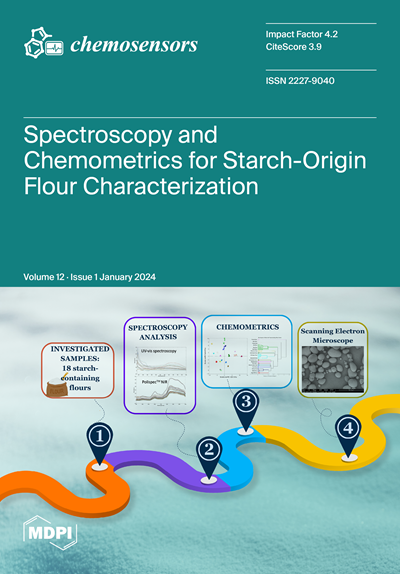Bioengineered Flagellin–TiO2 Nanoparticle-Based Modified Glassy Carbon Electrodes as a Highly Selective Platform for the Determination of Diclofenac Sodium
IF 3.7
3区 工程技术
Q2 CHEMISTRY, ANALYTICAL
引用次数: 0
Abstract
This study describes the incorporation of bioengineered flagellin (4HIS) protein in conjunction with TiO2 anatase nanoparticles into a chitosan (Chit) polymeric matrix as a highly sensitive electrode modifier for the determination of diclofenac sodium (DS) in wastewater. Two types of electrodes were prepared using a simple drop-casting method. The inner structure of the obtained modified electrode was characterized by scanning electron microscopy (SEM) in combination with energy-dispersive X-ray spectroscopy and isothermal titration calorimetry (ITC). The electrochemical and electroanalytical parameters of DS oxidation at the nanostructured interface of the modified electrode were obtained via cyclic voltammetry and square-wave voltammetry. The analytical parameters for diclofenac electro-detection showed a 50% decrease in LOD and LOQ at Chit + TiO2 + 4HIS/GCE-modified electrode compared with the Chit + 4HIS/GCE-modified electrode. The obtained tools were successfully used for DS detection in drug tablets and wastewater samples. Thus, it was demonstrated that in the presence of a histidine-containing flagellin variant, the electrode has DS recognition capacity which increases in the presence of TiO2 nanoparticles, and both induce excellent performances of the prepared tools, either in synthetic solution or in real samples.基于生物工程鞭毛菌素-TiO2 纳米粒子的改性玻璃碳电极作为高选择性平台用于测定双氯芬酸钠
本研究描述了将生物工程鞭毛蛋白(4HIS)与二氧化钛锐钛酶纳米颗粒结合到壳聚糖(Chit)聚合物基质中,作为一种高灵敏度电极修饰剂,用于测定废水中的双氯芬酸钠(DS)。采用简单的滴铸法制备了两种电极。利用扫描电镜(SEM)、能量色散x射线能谱法和等温滴定量热法(ITC)对改性电极的内部结构进行了表征。通过循环伏安法和方波伏安法测定了改性电极纳米界面上DS氧化的电化学和电分析参数。双氯芬酸电检测分析参数显示,Chit + TiO2 + 4HIS/ gce修饰电极的LOD和LOQ比Chit + 4HIS/ gce修饰电极降低了50%。该工具可用于药物片剂和废水样品的DS检测。因此,实验证明,在含有组氨酸的鞭毛蛋白变体存在的情况下,电极具有DS识别能力,并且在TiO2纳米颗粒存在的情况下,电极具有DS识别能力,并且无论是在合成溶液中还是在实际样品中,都能诱导制备的工具具有优异的性能。
本文章由计算机程序翻译,如有差异,请以英文原文为准。
求助全文
约1分钟内获得全文
求助全文
来源期刊

Chemosensors
Chemistry-Analytical Chemistry
CiteScore
5.00
自引率
9.50%
发文量
450
审稿时长
11 weeks
期刊介绍:
Chemosensors (ISSN 2227-9040; CODEN: CHEMO9) is an international, scientific, open access journal on the science and technology of chemical sensors published quarterly online by MDPI.The journal is indexed in Scopus, SCIE (Web of Science), CAPlus / SciFinder, Inspec, Engineering Village and other databases.
 求助内容:
求助内容: 应助结果提醒方式:
应助结果提醒方式:


